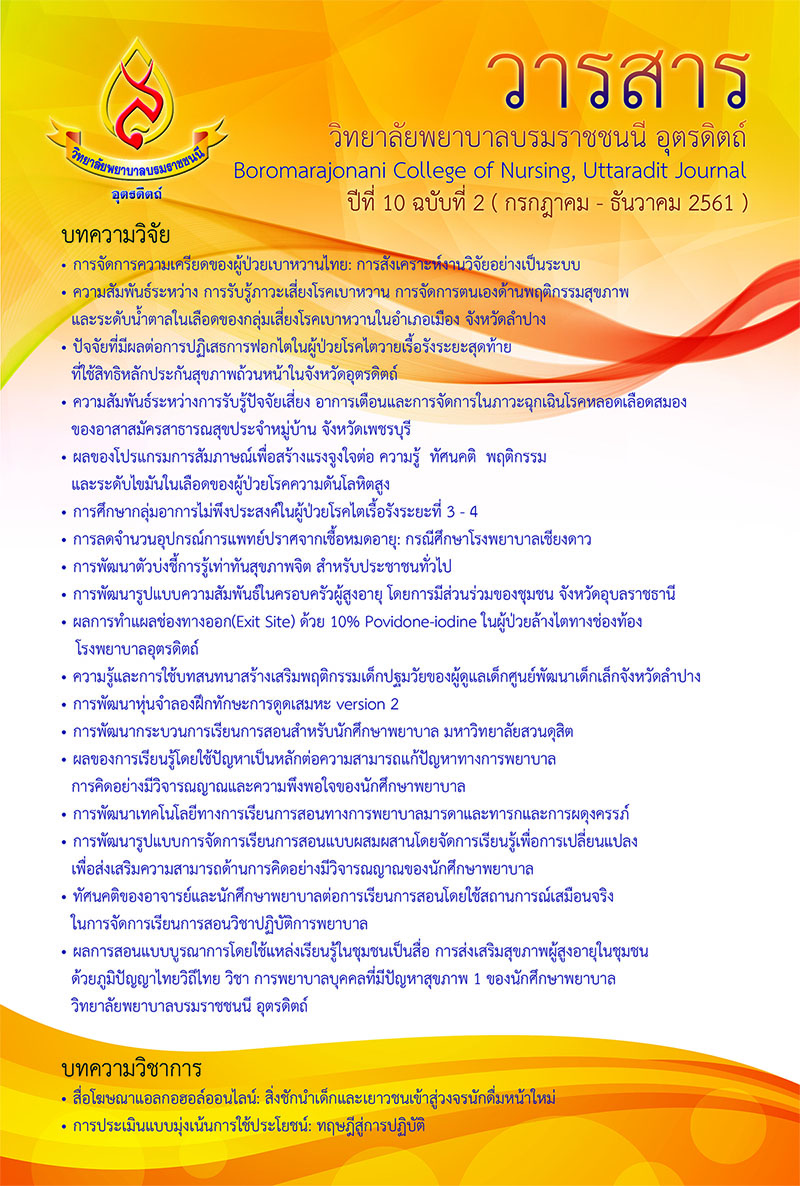การพัฒนาเทคโนโลยีทางการเรียนการสอนทางการพยาบาลมารดาและทารกและการผดุงครรภ์
Main Article Content
บทคัดย่อ
การวิจัยเชิงปฏิบัติการนี้มีวัตถุประสงค์เพื่อศึกษาความต้องการ การพัฒนา และการประมินความพึงพอใจของเทคโนโลยีทางการเรียนการสอนทางการพยาบาลมารดาและทารก และการผดุงครรภ์ จากนิสิตพยาบาลศาสตร์ ชั้นปี 3 และ 4 คณะพยาบาลศาสตร์ มหาวิทยาลัยนเรศวร ปีการศึกษา 2557 การดำเนินการวิจัยในการเสนอครั้งนี้แบ่งได้เป็น 3 ขั้นตอนของวงจรวิจัยเชิงปฏิบัติการนี้ ได้แก่ 1) ขั้นตอนของการประเมินความต้องการเทคโนโลยีฯ จำนวนผู้ร่วมวิจัย 68 ราย 2) ขั้นตอนการพัฒนา และ3) ขั้นตอนการหาความพึงพอใจเทคโนโลยีทางการเรียนการสอนทางการพยาบาลมารดาและทารก และการผดุงครรภ์ จำนวนกลุ่มตัวอย่าง 63 ราย เครื่องมือที่ใช้ในการวิจัย ได้แก่ แบบสอบถามข้อมูลทั่วไป แบบสอบถามเชิงคุณภาพเกี่ยวกับความต้องการเทคโนโลยีทางการเรียนการสอนและแบบสอบถามความพึงพอใจของเทคโนโลยีการเรียนการสอน แบบสอบถามเชิงปริมาณมีค่าความเชื่อมั่นมากกว่า .80 วิเคราะห์ข้อมูลเชิงปริมาณโดยสถิติเชิงพรรณนาและวิเคราะห์เชิงเนื้อหาของข้อมูลเชิงคุณภาพ ผลการวิจัยสรุปได้ดังนี้
ผู้เรียนต้องการเทคโนโลยีที่สนับสนุนการเรียนรู้ในรูปแบบ สื่อการเรียนการสอนออนไลน์ (24 ราย) คอมพิวเตอร์ช่วยสอน (24 ราย) เว็บไซต์ (16 ราย) และสื่อการสอนผ่านเครือข่ายมือถือ (16 ราย) เมื่อพัฒนาเทคโนโลยีตามความต้องการของผู้ร่วมวิจัย พบว่า ผู้ร่วมวิจัยพึงพอใจเทคโนโลยีการเรียนการสอนดังกล่าวในระดับดีขึ้นไปทุกหัวข้อ และเมื่อสรุปประเด็นจากแบบสอบถามในข้อคำถามปลายเปิดพบว่าผู้เรียนต้องการให้มี
การพัฒนาเทคโนโลยีการเรียนการสอนทางการพยาบาล เนื่องจากส่งผลด้านบวกต่อการเรียนรู้ และผู้เรียนต้องการให้ผู้สอนผลิตสื่อสนับสนุนการเรียนรู้ครอบคลุมในทุกประเด็นหัวข้อ
Article Details
บทความหรือข้อคิดเห็นใดใดที่ปรากฏในวารสารวิจัยการพยาบาลและวิทยาศาสตร์สุขภาพ เป็นวรรณกรรมของผู้เขียน ซึ่งบรรณาธิการหรือสมาคมศิษย์เก่า ไม่จำเป็นต้องเห็นด้วย และบทความที่ได้รับการตีพิมพ์เผยแพร่ถือเป็นลิขสิทธิ์ของวารสารวิจัยการพยาบาลและวิทยาศาสตร์สุขภาพ
เอกสารอ้างอิง
2. Buranasak, J., Limruangrong, P., & Pungbangkadee, R. (2014). The effect of computer assisted instruction of abdominal examination on knowledge, abdominal axamination skills and satisfaction of nursing students. Journal of The Royal Thai Army Nurses, 15(3), 61-370. (in Thai)
3. Chaiwuth, S., Parisanyakul, S., Boosung, C., & Sangli, K. (2011). Development of a computer-assisted instruction program on labor progression. Nursing Journal, 38(3), 10-19. (in Thai).
4. Colaizzi, P. (1978). Psychological research as the Phenomenologist views it. In R. Valle, & M. King (Eds.), Existential – Phenomenological Alternatives for Psychology (pp. 48-71). London: Oxford University Press.
5. Glasgow, M. E., & Cornelius, F. H. (2005). Benefits and costs of integrating technology into undergraduate nursing programs. Nursing Leadership Forum, 9(4), 175-179.
6. Kemmis, S., & McTaggart, R. (1988). The Action research planner. Victoria: Deakin University.
7. Kimsungnoen, N., & Petchtang, S. (2016). The effect of e-learning courseware media on the learning achievement of nursing students at the School of Nursing. Thai Red Cross Nursing Journal, 9(1), 63-74. (in Thai)
8. Klankhajhon, S., Rithpho, P., Boonpracom, R., & Piengjing, K. (2015). Development of the computer assisted instruction :Regarding to the breastfeeding. Journal of Nursing and Health Science, 9(1), 67-82.
9. Lasuka, D. (1997). Computer assisted instruction focused on Tuturial aspect for student nurses. Chiang Mai: Chiang Mai University. (in Thai)
10. Lasuka, D. (2000).Application informatics in nursing education. Nursing Journal, 27(1), 1-16. (in Thai)
11. Neamsakul, W. ( 2017). The first time experiences to assisting childbirth of the third year nursing student. Boromarajonani College of Nursing Uttaradit Journal, 9(2), 1-17. (in Thai)
12. Nimanan, S. (2006). Instructional media application. In Phuwipadawat, P. Instructional manual. Chiang Mai: Klong Thong. (in Thai).
13. Nantsupawat, A., & Nantsupawat, R. (2013). Satisfaction and outcomes of the teaching styles with blended learning in a nursing leadership and management course. Nursing Journal, 40(Suppl), 47-60. (in Thai)
14. Office of the National Education Commission. (1999). National education act B. E. 2542. Bangkok: Office of the National Education Commission. (in Thai).
15. Pedersen, S. & Williams, D. (2004). A comparison of assessment practices and their effects on learning and motivation in a student - centred learning environment. Journal of Educational Multimedia and Hypermedia, 13(3), 283-307. Retrieved June 17, 2015 https://goliath.ecnext.com/coms2/gi_0199-3573153/A-comparison-of-assessment-practices.html
16. Puengchompoo, W., & Panuthai, S. (2014). Developing of the learning and teaching with E-learning model for undergraduate nursing students in a gerontological nursing Course. Nursing Journal, 41(5), 21-25. (in Thai)
17. Sriamonruttanakul, J. (1997). The construction of computer assisted instruction in public health nursing of epidemiology and surveillance for sophomore nursing students in Baromrajonani college of nursing, Bangkok. (Unpublished master’s thesis). Mahidol University, Bangkok. (in Thai)
18. Skinner,B. F. (1969). Contingencies of reinforcement: A theoretical analysis. New York: Appleton-Century-Crofts.
19. Songkram, R. (2003). Development of computer assisted instruction on nonphamacological of pain relief in parturient during first stage of labor for student nurses (Unpublished master’s thesis). Naresuan University, Phitsanulok. (in Thai).
20. Tambon, S., & Chaiyarit, A. (2017). Learning preparation for improving management competency of nursing students. Boromarajonani College of Nursing Uttaradit Journal, 9(2), 54-69. (in Thai).
21. Thailand Nursing Council and Midwifery. (2015). Nursing and midwifery education and accreditation. Retrieved June 17, 2015 from www.tnc.or.th/en (in Thai)
22. Viseskul, N., Aree, P., Tantisirin, L., Suwan, N. (2003). Effect of tutorial teaching through the computer assisted instruction regarding positioning technique and body machanics of patient on knowledge of nursing students. Chiang Mai: Faculty of Nursing, Chiang Mai University.
23. Xuto, P., Niyomkar, S., & Yothayai, C. (2014). The effect of using blended learning to improve nursing students ‘information technology competency as a way to support of training for fourth year nursing students. Journal of Nursing and Education, 7(4), 156-167. (in Thai)


